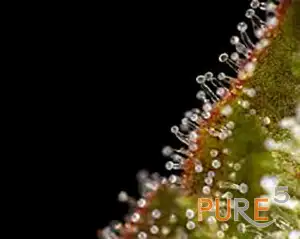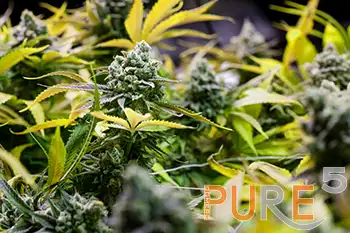Importance of Terpenes in Cannabis
Terpenes, fragrant substances that are present in many plants, including cannabis, are what give the plant its distinctive flavor and aroma. In cannabis, terpenes are believed to work together with cannabinoids to produce the entourage effect, which enhances the therapeutic benefits of the plant. In this response, we will explore the importance of terpenes in cannabis extraction and the different methods used to extract them.
Table of Contents
ToggleUnderstanding Terpenes

Common terpenes found in cannabis and their unique characteristics
Some of the most common hemp terpenes are myrcene, caryophyllene, and limonene. Myrcene, which is also found in hops and lemongrass, gives cannabis a mildly sweet and musky flavor. Caryophyllene, present in other plants like cloves and black pepper, adds a spicy and peppery bite to certain cannabis strains. Limonene, which can be found in citrus fruits and ginger, provides a clean, fresh, and uplifting citrus aroma to many cannabis cultivars.
The effects of several terpenes have been studied, and they include anti-inflammatory, antiviral, anticancer, antibacterial, and pain-relieving properties.
While terpenes like myrcene, caryophyllene, and β-pinene have been connected to pain relief, limonene has shown potential as a cancer-preventative and anti-tumor agent.
The relationship between terpenes and the entourage effect
By interacting with the body’s endocannabinoid system, terpenes may strengthen the effects of cannabinoids like THC and CBD. The entourage effect, when the combined action of many substances results in a more effective and comprehensive therapeutic experience, is a term used to describe this synergy between terpenes and cannabis. Understanding the role of terpenes in cannabis is crucial for maximizing the potential benefits of cannabis consumption and developing targeted treatments.
It’s crucial to remember that although in vitro and preclinical research have shed light on the medicinal advantages of terpenes, more studies, particularly in human models, are required to fully comprehend these substances. However, there is a lot of hope for the future of cannabis treatment in the growing research in terpenes and their interactions with other cannabis components.
Terpene Extraction Methods
Cannabis terpenes are often extracted using one of two techniques: solvent-based extraction or solventless extraction. The graphic below shows bars representing the solubility of several solvents in addition to a variety of organic compounds. For the extraction of the full spectrum resin, understanding the solvent is crucial. It is crucial to choose your solvent base carefully when deciding what component to extract because plants have compounds that are soluble in oil, alcohol, and water.
Solvent-Based Extraction Methods
The excellent extraction efficiency of solvent-based extraction techniques for a variety of cannabinoids and terpenes, including hydrocarbon and ethanol extraction, is well recognized.
However, the use of potentially hazardous solvents like butane, propane, and ethanol makes these procedures unsafe. In contrast, CO2 extraction offers a bit safer alternative with high yield and cost-effectiveness for mass manufacturing. It selectively extracts desired compounds while minimizing unwanted components. However, CO2 extraction like the other solvent based methods has its limitations, including the costly equipment required, which can pose challenges for small-scale producers, and the potential impact on the preservation of delicate terpenes, which may influence the overall terpene profile of the extracted substance. Careful consideration of specific production goals, scale, and terpene preferences will help determine the most suitable extraction method for achieving desired outcomes.
Solventless Extraction Methods
Solventless extraction methods, such as rosin pressing and ice water extraction, are considered more environmentally friendly and eliminate safety concerns associated with solvents. These methods preserve the natural flavors and aromas of the extracts and are less labor-intensive than solvent-based methods. However, solventless extraction methods have lower extraction efficiency compared to solvent-based methods, which can result in lower yields of cannabinoids and terpenes.
R134A Aerosol Extraction Method
The R134A aerosol extraction method is a solventless process for cannabis extraction that uses a low-pressure, room-temperature, non-polar fluorocarbon solvent to capture every potential terpene along with elements and ketones all suspended in the natural oils from the hemp flowers. R134A is much less miscible with the extracts than butane, which is a commonly used solvent in cannabis extraction. The R134A aerosol extraction method has a half-hour to an hour purge of the R134A built into the vendor’s process, which reduces the concentration to very low levels.
R134A extraction is a new and efficient method that can preserve hemp terpenes in a span of 10 to 15 minutes. The extraction process employs a low-pressure, room-temperature, non-polar fluorocarbon solvent, allowing for the capture of every potential terpene along with elements and ketones all suspended in the natural oils from the hemp flowers. Since the extraction is carried out at room temperature, there is no destruction of existing terpenes or new by-products created in the process, maintaining the terpene, enzymatic, and mineral content intact.
Terpene Preservation

In comparison to other extraction methods, R134A extraction is a solventless method that eliminates safety concerns associated with solvents. It is also more environmentally friendly and less labor-intensive than solvent-based methods. However, solventless extraction methods have lower extraction efficiency compared to solvent-based methods, which can result in lower yields of cannabinoids and terpenes.
Factors Affecting Terpene Extraction
Several factors can affect terpene extraction, including temperature, extraction duration, polarity of the solvent, quality of plant material, and pressure.
Temperature and Terpene Volatility
Terpenes are sensitive to heat and pressure, and either can ruin the oils’ aroma, flavors, or chemical structure. Their molecular structure is altered with even moderate heat or pressure stress. Therefore, it is essential to extract terpenes gently at a very low temperature in a manner that will render the resulting product unadulterated.
Extraction Duration and Terpene Degradation
Extraction duration can also affect terpene extraction. Prolonged exposure time to high temperatures can cause decreased terpene stability and degradation. Therefore, it is essential to use extraction methods that do not involve high temperatures to preserve terpenes or solvents that degrade them.
The polarity of the used solvent

The Pressure
Now, let’s address the impact of pressure on terpene extraction. High pressure can be detrimental to the preservation of terpenes. When exposed to elevated pressure, terpenes can undergo structural changes and lose their aromatic and flavor characteristics. Therefore, it is crucial to avoid high-pressure conditions during the extraction process to maintain the integrity of terpenes.
The Importance of Quality Plant Material

The R134A aerosol extraction method is a solventless process for cannabis extraction that can preserve terpenes. Terpene preservation is critical during the extraction process to ensure the full spectrum of the cannabis plant is maintained, providing improved health benefits, aroma, and flavor. Several factors can affect terpene extraction, including temperature, extraction duration, and the quality of plant material used. Therefore, it is essential to use extraction methods that do not involve high temperatures and high-quality plant material for terpene extraction.
FAQs on Terpenes in Cannabis
What is the significance of terpenes in cannabis?
Terpenes are naturally occurring chemical compounds found in plants, including cannabis. They are responsible for the aroma, flavor, and even color associated with various types of vegetation. In terms of cannabis, terpenes are what make certain strains smell or taste different from others. They can also be processed into products, like cleaning solvents, pesticides, and dyes. Some terpenes even have therapeutic properties.
How are terpenes extracted from cannabis?
Terpenes can be extracted from cannabis using various methods, including solvent-based and solventless methods. Solvent-based methods involve using hydrocarbons and gasses like butane, ethanol, nitrogen, or CO2, while solventless methods use low-pressure, room-temperature, non-polar fluorocarbon solvents.
Which extraction method is most effective for preserving terpenes?
The most effective extraction method for preserving terpenes is a solventless method that uses low-pressure, room-temperature, non-polar fluorocarbon solvents, such as the R134A aerosol extraction method. This method allows for the capture of every potential terpene along with elements and ketones all suspended in the natural oils from the hemp flowers, maintaining the terpene, enzymatic, and mineral content intact.
How does the R134A aerosol extraction method affect terpene retention?
The R134A aerosol extraction method is a solventless process that uses a low-pressure, room-temperature, non-polar fluorocarbon solvent to capture every potential terpene along with elements and ketones all suspended in the natural oils from the hemp flowers. Since the extraction is carried out at room temperature, there is no destruction of existing terpenes or new by-products created in the process, maintaining the terpene, enzymatic, and mineral content intact.
Can terpenes be added back to extracts after extraction?
Yes, terpenes can be added back to extracts after extraction. This is often done to improve the flavor and aroma of the final product. When adding terpenes back to extracts, it is important to start with a low amount (less than 0.5%) and increase the amount as necessary.
Do terpenes have any therapeutic benefits?

Are there specific terpenes that are more commonly associated with certain effects?
Yes, there are specific cannabis terpenes that are more commonly associated with certain effects. For example, myrcene is commonly associated with sedative effects, while limonene is associated with uplifting effects. However, the effects of terpenes can vary depending on the individual and the specific strain of cannabis.
Conclusion
Terpenes play an important role in the aroma, flavor, and potential therapeutic benefits of cannabis. There are various extraction methods that can be used to extract terpenes from cannabis, with R134a aerosol method being the most effective for preserving terpenes. Factors such as temperature, pressure, extraction duration, and plant material quality impact terpene extraction. Understanding the science behind terpenes and employing advanced extraction equipment can elevate the quality of cannabis extracts and contribute to the success of businesses in the cannabis industry.









